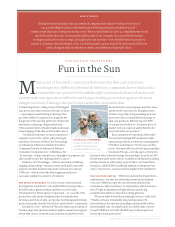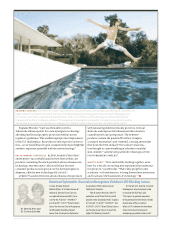Johnson and Johnson 2006 Annual Report Download - page 20
Download and view the complete annual report
Please find page 20 of the 2006 Johnson and Johnson annual report below. You can navigate through the pages in the report by either clicking on the pages listed below, or by using the keyword search tool below to find specific information within the annual report.
J O H N S O N & J O H N S O N 2 0 0 6 A N N U A L R E P O R T
says that the team “engineered against failure” by creating
a timeline that gave specific details for each research and
development function on a day-to-day—and, eventually,
hour-to-hour—basis: “We covered the walls of the Tibotec
facility in Mechelen, Belgium, with posters six feet long
and three feet wide. The posters illustrated the interplay of
functions and deliverables, and were a constant reminder
of deadlines and commitments.”
Another original team member, Marie-Pierre de Bethune,
Vice President of Clinical Virology, says: “Our motto was ‘The
patients are waiting.’ It drove us to work in a way that Paul
called ‘faster than possible,’ without compromising on quality,
science or ethics. We made many personal sacrifices to meet a
highly accelerated timeline. For instance, during high-output
months, we restricted vacation times. And when it came time
to work on the application for health authorities, the core team
went off-site to a remote location in northeast Belgium for an
entire week, working from 7 a.m. to 11 p.m. each day.”
The discipline paid off. Only five
years elapsed between the first study
in humans (January 2001) and the
submission of filings (December 2005).
Says Stoffels: “In drug-development
terms, this is an extremely short time.”
A DEEP CO M M I TME N T TO HIV
In addition to PREZISTA™, which was
known as TMC114 throughout the
development process, Tibotec has two
other novel antiretrovirals—TMC125
and TMC278—in development. Both
investigational drugs are NNRTIs—
non-nucleoside reverse transcriptase
inhibitors.
TMC125, in late-stage develop-
ment, is the first investigational
NNRTI to show significant activity
in patients with prior NNRTI failure.
Clinical trials are also being conducted
to investigate its use in combination
with PREZISTA™. TMC278, an early
development compound, is highly
potent and, if successful, could become
the backbone for fixed-dose
combination therapy in a single pill.
The company continues to create
its own path in the world of HIV.
Another NNRTI compound, TMC120,
was licensed by the company to
the International Partnership for
Microbicides, a nonprofit product
development partnership, for develop-
ment as a vaginal microbicide. This
agreement, signed in 2004, was the first
royalty-free licensing arrangement of
its kind in microbicide research and
is an approach that has since been
repeated by other manufacturers.
HIV IN WO M E N : A SPEC I A L S T U DY On the research front,
Tibotec Therapeutics—the company’s U.S. marketing,
sales and clinical arm—initiated in 2006 the largest clinical
study ever conducted among treatment-experienced adult
women with HIV. The GRACE (Gender, Race and Clinical
Experience) study is comparing gender differences in the
efficacy, safety and tolerability of PREZISTA™ administered
with other antiretroviral agents over a 48-week treatment
period. The study, which is being conducted at sites
throughout the U.S., Mexico and Canada, also explores racial
differences in treatment outcomes.
Says McHugh: “Although women represent nearly 50
percent of all infections worldwide, they are vastly under-
represented in HIV clinical trials—even though research to
date not only suggests that women may tolerate HIV medica-
tions in different ways than men but also suggests that certain
complications of the disease may be gender-specific.
We’ve worked very closely with the U.S. HIV community in
G LO B A L H E A LT H “Infectious diseases represent our greatest unmet
medical challenges,” says Julie McHugh, Company Group Chairman,
Virology. Adds Roger Pomerantz, M.D., FACP, President, Tibotec Research
and Development: “Our new compound, PREZISTA™, ‘fits’ HIV neatly,
making it extremely difficult for the virus to mutate.”
18
























